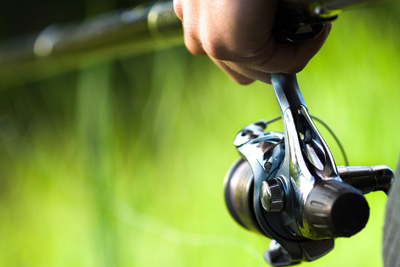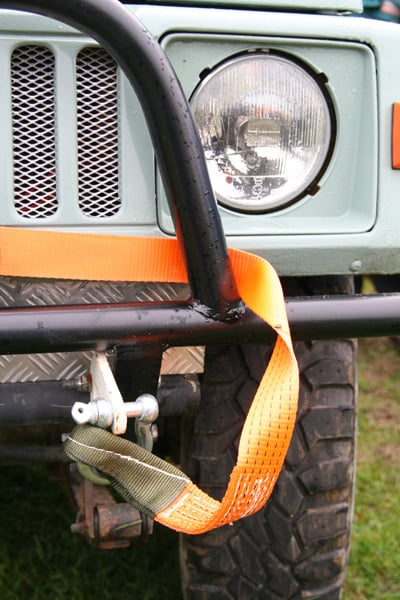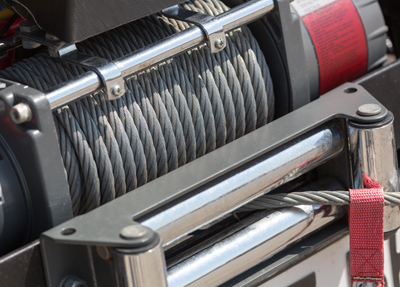Gone Winching: Using and Maintaining Your Jeep Winch
Tips and Tricks for Keeping Your Winch Workable
In this Article

If a roll cage for your Jeep is an investment you never want to use, a winch is one you don’t mind pressing into service. In rocky, muddy or sloping terrain conditions, winches win the day as useful Jeep 4x4 accessories to get off-roaders out of jams. Because they’re thought of as conditional tools, proper use is stressed, but maintenance can often be an afterthought.
Comparisons can be drawn between winching and fishing. As any boat owner knows, taking a fishing boat out on the water involves preparation, the actual fishing, and then post-boating procedures. For instance, if you’re in saltwater your boat has to be thoroughly cleaned afterwards – leaving salty water on a boat is a bad idea. After a trip, checking a boat’s propeller for damage and applying waterproof grease keeps it from corroding and seizing into place. These spot checking, cleaning and lubricating procedures apply to winches, too.
Winching is also similar to spooling out a fishing line, only instead of trying to catch a fish you’re trying to snatch a vehicle or haul an obstruction. Here are some use and maintenance tips to follow for your Jeep winch to optimize recovery and ensure safety and an extended life.

Safety Counts
Before you use your winch, inspect your line, safety hooks and straps. Only hook authorized and real tow points on the Jeep. The first safety protection is to put on a pair of thick leather gloves to defend your hands from frays in winch wires. Always pay attention and respect straps and jacks – they can be dangerous.
Winches are most commonly used for self-recovery, but if you’re towing another vehicle communication is key. Use remote radios or pre-arranged hand commands to stay on the same page with others. Try to get as far back as possible from the other vehicle and keep in mind the more line you have out, the more winching power you have. Put the Jeep you’re recovering in park and when you’re trying to pull a vehicle back onto its wheels never have someone in it.
A line pull with 1.5 to 2 times the weight of your vehicle is the general rule of thumb – so if your Jeep weighs 4,500 lbs. make sure your winch line pull is at least 9,000 lbs. Synthetic is lighter, stronger, more forgiving and safer than steel and if the cable should break it will drop because it doesn’t have the same mass as steel.
A blanket, floor mat, sweatshirt or tube sock with two tennis balls sewn into either end can be draped over the winch line helps in case the cable breaks. There are also shot bags sold specifically for this. Whatever you choose to drape needs to be at least in the midpoint of the line and putting your Jeep’s hood up prevents a snapped cable from accidently coming up through a windshield. Thimbles are great aids for sturdier, safer winching. When re-spooling, stand at least an arm’s length distance from the winch and walk the line hand-over-hand.
Another practical tip is to put your controller away to ensure it’s not plugged in when you’re driving around.
Slow and Steady
“If you’re going to pull out or free spool your winch line, do it slowly and steadily,” says Recovery Specialist Michael Finch. He cautions that once it backwinds, it can get caught and become knotted. “It’s the same concept as fishing when the line backwinds on itself.”
Once you’ve performed recovery, drag your line all the way out and pull on it to create tension and prevent soft spots and loose spots in the drum. “Keep an eye on your winch line and don’t let it ball up at one end of the drum and get tied up in knots,” says Smittybilt Brand Manager Glen Kukula. If this starts to happen, he cautions to stop right away and reposition your Jeep then rewind the rope correctly and start over. “The bundling, all-in-one effect is bad for winches and it breaks the tie rods,” he says.

Maintenance Tips
Winch handles, rollers and connections call for inspection and maintenance on a regular basis to ensure they function at full capacity. Neglecting to do this ends up costing you in repairs and possible replacement costs. Smittybilt’s line of X20 winches come with Lifetime Mechanical Warranties and 5-Year Electrical Warranties, but proper care and maintenance will help you avoid using warranty coverage.
With a steel cable, be vigilant about kinking and fraying. “Check the line for frays and nicks and lubricate a steel line if it’s required,” says Kukula. WD40 and light oil work well as lubricants, but some winches don’t require lubrication.
Use a towel with soap and water to wash off dirt, dust and leaves. Mud that accumulates while off-roading and is left on a winch causes it to deteriorate faster. Hose it down and make sure it’s dry before spooling it back in as a wet winch line will rust and diminish in capacity. Examine your electrical connections for corrosion and be sure bolts and connections are on tight. Dialectric grease can be used to combat corrosion of electrical connections.
Constructed from hi-tech polyethylene, synthetic winch maintenance is far easier. They are snag and burr free and have a higher breaking strength. The drawback is that UV rays can compromise rope strength. You want to clean off dirt, sand and debris, but as far as cleaning goes hosing down a synthetic rope will do the trick.
Join our mailing list to receive information on new products, special events, discounts and more!
Sign up to receive deals by email!
Sign up to receive text alerts about new product releases, exclusive access to sales, and much more!
Sign up to receive deals by text!
By submitting, you agree to receive recurring autodialed marketing text msgs (e.g. cart reminders) to the mobile number used at opt-in from 4 Wheel Parts (4WP) on 21208. Consent is not a condition of purchase. Msg frequency may vary. Msg & data rates may apply. Reply HELP for help and STOP to cancel. See Terms and Conditions & Privacy Policy








